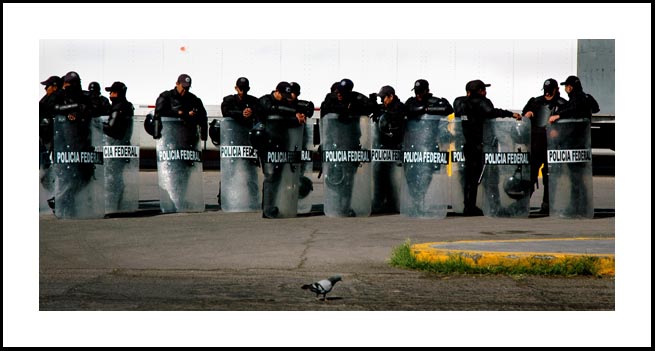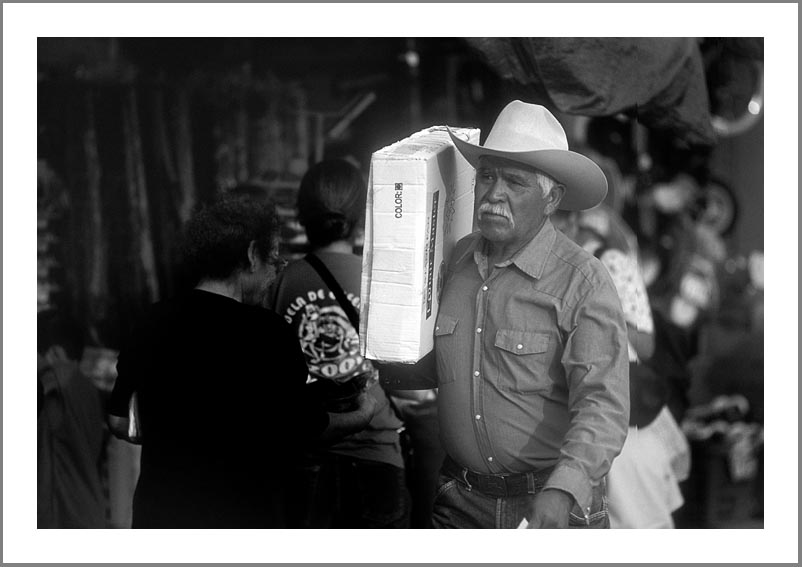[flagallery gid=6 name=”Gallery”]
Is there any Light at the end of Juárez’s tunnel?
There are a lot of things in Juárez these days: widows, widowers, killers, thugs, riddled bodies, drug addicts, every day normal people, kids going to school, people being married, bombs and death across the street (almost) from the old “City Market.” Everything.
There is very little Light.
The city seems to have turned from sunny and bright and colorful to Black and White, like an old photograph, one that wasn’t “fixed,” very well and is losing it’s contrast and fading away. The brightness is gone. Light is at a premium, right now, for sure, in Juárez.
At times, the city seems like the old city, the vibrant Juárez, like it used to be, full of energy and beautiful people and moments of sweetness and surprise (in a good way). Juarenses have verve.
Now, much of that vevre is being used in murder and kidnapping and butchery.
These are not the people who can turn on the Light.
The Cruz Roja Mexican de Juárez EMS’s are.
For the EMS’s of the Cruz Roja , things can change fast. The EMS’s spend a lot of time, waiting, killing time, and time can drag at their headquarters. They wash their ambulances, read, get shoe shines, tell jokes, make light of their days’ experience. Hurry up and wait. As it is anywhere. Some days, one can even imagine, no calls coming in at all.
Dream on.
In an instant, it all changes. A call comes, the world turns faster, they jump in their “buses,” the sirens scream, rock ‘n roll.
Anticipation, fear, it itches, sweat rises, stomach turns a little, but these guys are pure efficiency, focused, on it! The speed of the chase subdues the adrenalin. The chase itself is the adrenalin. Truth is, if you don’t like this kind of adrenalin this isn’t for you.
Anticipation. In Juárez, the darkness can come anywhere, anytime, to anyone.
We scream toward the call and one asks, Is it someone I know? Is it someone I don’t know but is friend of someone I know? Is it another act of terror? Or is it just the every day, “normal,” bullet-riddled body laying in the street? You could think, Don’t let my kids see a decapitated body. The ambulance screams forward, cars shoot in front of you. Pendejos! You fight your way through Calle Triunfo de la Republica, jetting past the few bars that are still the “go to,” bars, and head east or west, past the increasingly plentiful abandoned ghosts of the places people don’t go to anymore. Después de la violencia . Todo se vino después de la violencia. Everything, now, is after the violence came. The EMS’s go through their mental checklist. Do I have everything? The other side of your brain kicks in, too: don’t let this one be too grizzly. Please, don’t let it be someone too young or too old, or too beautiful, or too innocent.
In the end, in Juárez these days -how could you not think it- don’t let it be me!
This goes on, day after day. It won’t end. Everything ends. This won’t end. It’s been almost four years now. Or has it been longer? The EMS’s keep themselves tight, do the job, find ways to cope. “I always try to remember what my kids look like when I walk in the door at night,” says Jose, one of the EMS’s, “that’s what keeps me going.”
In 2005 there were 235 murders in Juarez. That seem almost “quaint,” compared to where we are now, with over 1600 decimated last year, and this year running ahead of that.
Is there any glimmer of hope in all of this? Most days, it seems like the answer is, no.
If there is any Light, it is here, in these ambulances, with these men and women, these saviors, Estos salvadores.
Here is some hope. The determined and brave EMS’s of Juarez. Many are volunteers. Some are volunteers from El Paso. Brothers and sisters with helping hands. Some have been injured in this war and now some have died, but they do it, day after day. This is the bravery of the giver, the courage of one who is committed to the good, no matter what. This is the bravery of those committed to being the light no matter how deep is the darkness.
The Cruz Roja Mexicana (Mexican Red Cross) works the mean streets of Juárez, Mexico. They work against the odds. They work hope into the face of despair.
The City and the Red Cross have merged because of budget deficits and because of the ongoing violence in the embattled city of Juárez. Because of the expanding budget crisis, 15 EMS/Cruz Roja workers were laid off while the murder rate in Juarez reached record high levels of about 250 people for the month of July, and about 1,650 people this year.
These “guys (there are several women EMS’s),” don’t do this for the money, though. It’s too hard, just for money. It would be impossible for just the money. This is a calling, not a job.
The numbers are for the number crunchers. Let someone else count the bodies, the Cruzanos tend to them.
This is hands on stuff, smelly stuff, sticky and wet and staining, this is blood and puke and urine and shiot and, occassioinally, a heart beat comes back, occasionally things turn out well. The EMS’s don’t know about numbers -except for heart rates, response- times, amount of calls taken, how long before an untreated wound can bleed out, or simply, the amount of time waiting before the next call comes. They know about blood and grasping hands and relative’s wales. They know about tears. They know about the pride of doing a miracle and the frustration of not being able to do one.
The Cruz Roja Mexicana de Juárez responds to all calls, from stomach aches to inebriation, from cut fingers to bullet wounds.
Not everything is about the Drug War. Sometimes their calls are simple, a stomach ache, a fever, flu, a drunken person down on the street.
They respond to it all.
In the end, ocassionally overwhelmed, as everyone in Juárez is, they know about hope and they know about futility and they know about God.
The EMS’s of the “world’s most deadly city,” are the Light of Juárez.


